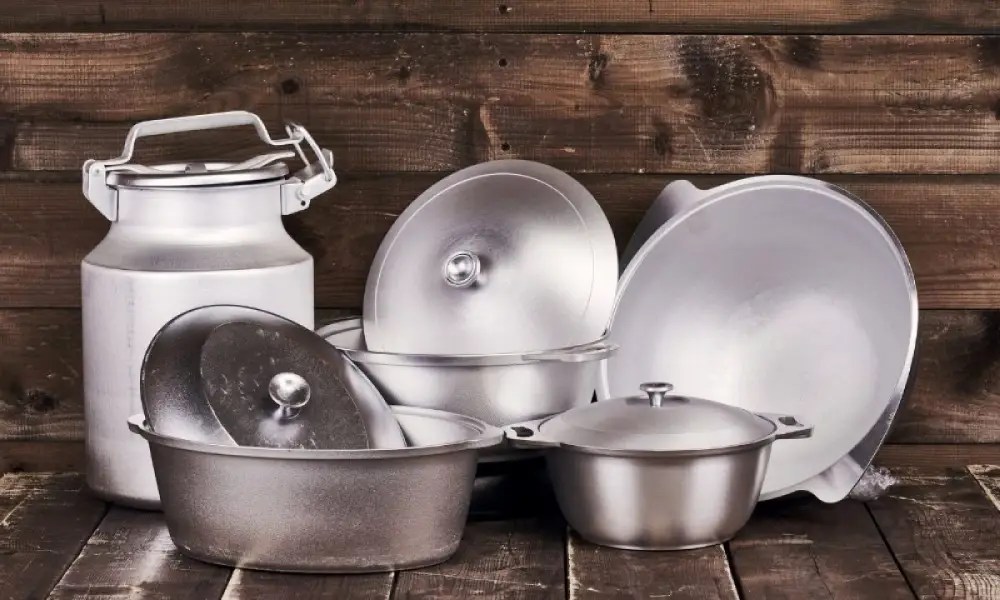• Aluminum
Aluminum Cookware : Essential Information for All Individuals

Reviewed by Trinity Anderson
Last Updated December 2023

Wondering about Aluminum Cookware? Here’s an interesting fact…
Based on the data provided by the Cookware Manufacturers Association, nearly 60% of cookware sold in the United States in 2015 consisted of aluminum cookware. This indicates that a significant majority of individuals in the country utilize aluminum cookware.
However, despite its widespread usage, there appears to be a lack of comprehensive knowledge regarding this type of cookware. It is not uncommon for me to receive daily inquiries or requests for detailed evaluations on aluminum cookware. Some common questions include:
- Can you explain the concept of anodized aluminum?
- Could you provide a definition for hard anodized aluminum?
- How does hard anodized aluminum differ from non-stick cookware?
And the overriding question: Is aluminum cookware safe?
My goal is to have answers to all those questions by the end of this article. And more.
Why use aluminum?
Aluminum, being an excellent heat conductor, is an optimal selection for cookware due to its remarkable properties. To provide a clear comparison, a table has been provided to showcase the thermal conductivity of various metals. The measurement unit used for thermal conductivity is w/m.k or watts per meter-kelvin. It is worth noting that Aluminum possesses a thermal conductivity that is 16 times higher than that of stainless steel.
Consequently, this implies that when using Aluminum cookware, you can expect it to heat up rapidly, evenly, and a staggering 16 times faster than a pot made of stainless steel!
What Everyone Needs to Know About Aluminum Cookware
| Material | Thermal conductivity (W/m.K) |
|---|---|
| Copper | 401 |
| Aluminum | 237 |
| Nickel | 91 |
| Cast Iron | 80 |
| Tin | 67 |
| Stainless Steel | 14.2 |
Aluminum, being the third most abundant element in nature, is widely available at a low cost. This makes aluminum cookware generally affordable and highly favored due to its lightweight nature.
The problem with Aluminum is...
Due to the reaction between aluminum and acidic food, the metal tends to leach into the food. As a result, the majority of aluminum cookware in the market is either coated with a non-stick layer or anodized.
What is anodized aluminum?
Let's delve into some basic chemistry. When aluminum is exposed to air, it undergoes a natural process of forming a thin layer of aluminum oxide on its surface. Despite its thinness, this layer is incredibly strong and acts as a barrier between the metal and the air, preventing further oxidation. This process is referred to as 'passivation' and renders the metal passive rather than reactive.
Interestingly, aluminum oxide is also the material used to make sapphires and rubies, albeit in different colors. Due to its hardness, aluminum oxide is also utilized as a commercial abrasive.
To create a thicker layer of non-reactive aluminum oxide, the metal undergoes an electrochemical process called anodization. This results in a much thicker layer of aluminum oxide, known as anodized or hard-anodized aluminum.
Is anodized aluminum the same as hard anodized aluminum?
Although both suggest the presence of an aluminum oxide layer on the metal surface, there exists a distinction between them. Essentially, hard anodized refers to a thicker layer of aluminum oxide compared to regular anodized. As a result, the metal becomes twice as strong as stainless steel and exhibits durability, non-reactivity, and resistance to both corrosion and abrasion.
Can hard anodized aluminum peel off?
The anodized aluminum possesses a layer of aluminum oxide that is distinct from paint or any coating, as it is seamlessly integrated with the underlying metal. Consequently, it becomes an integral component of the aluminum, ensuring that it remains impervious to peeling or chipping.
According to certain reports, it is nearly as difficult as diamond, making it highly effective in preventing scratches and revealing the aluminum core beneath.
Is hard anodized aluminum non-stick?
Hard anodized aluminum is inherently low stick, although it is not completely non-stick. The majority of modern hard anodized aluminum pans are coated with a non-stick coating.
What’s the difference between hard anodized and non-stick?
Calphalon introduced anodized aluminum cookware in 1968 specifically for professional chefs, as they required cookware that could withstand their demanding needs. This innovative material was later made accessible to home cooks in 1976 through the Calphalon Commercial Hard Anodized line. However, this particular product is no longer available and has been replaced by traditional non-stick coated cookware.
Non-stick aluminum cookware, on the other hand, is made of aluminum with a non-stick coating. This coating can either be PTFE-based, such as Teflon, or ceramic-based. It is important to note that non-stick aluminum cookware may or may not be made of hard anodized aluminum.
Is a non-stick coated pan with hard anodized aluminum better than one with non-anodized aluminum?
A brief examination of Amazon reveals that a non-stick pan made of hard anodized aluminum generally carries a higher price tag compared to a non-stick pan made of plain aluminum. However, despite the additional cost, I would always recommend opting for a hard anodized non-stick pan or set over plain aluminum. Here's why:
First and foremost, hard-anodized aluminum undergoes an additional process that significantly enhances its hardness, strength, and resistance to scratches, in contrast to plain aluminum. Consequently, you obtain a much more durable pan due to the exceptional toughness of the hard anodized surface.
Secondly, the non-stick coating applied to a hard anodized aluminum pan has a significantly longer lifespan compared to a plain aluminum pan. In fact, according to Circuloncanada.ca, when subjecting a hard anodized aluminum surface and a plain aluminum surface with the same quality of non-stick coating to an abrasion test, the hard anodized material proved to be three times more durable!
Lastly, in the case of hard anodized pans, even if the non-stick coating wears off or gets scratched, the food will not come into contact with plain aluminum. As we are aware, aluminum reacts with certain foods, especially acidic ones, resulting in the leaching of metal into the cooked food. On the other hand, hard anodized aluminum is highly non-reactive.
In conclusion, it is worth investing the extra money in a hard anodized non-stick pan. Based on my personal experience, you will enjoy a much longer-lasting non-stick cooking surface.
What are the different types of aluminum cookware and best options for each?
There are five primary choices available when it comes to aluminum cookware. Below, you will find information about each option along with a recommendation for the top choice.
Plain aluminum
Uncoated and non-hard anodized aluminum is becoming increasingly scarce in North America due to its reactivity with food. However, there are still a few limited options available, such as the Cajun cookware aluminum Dutch oven.
Additionally, if you are currently seeking a pressure cooker, there are several exceptional stove top choices available, particularly those made of plain aluminum.
Plain aluminum with ceramic nonstick coating
Caraway cookware stands out as the most remarkable choice within this category. It is undeniably one of my preferred cookware sets, and I frequently rely on it for my everyday culinary endeavors.
Caraway cookware is made of heavy gauge aluminum with a stainless steel base so it can also be used with induction cooktops. The company also follows eco-friendly production methods which is why they prefer plain aluminum vs hard anodized.
Plain aluminum with Teflon/PTFE nonstick coating.
Unlike anodized aluminum, the aluminum in this set does not undergo hardening and strengthening processes. However, with proper care, it can still last for a few good years.
Hard anodized aluminum with ceramic nonstick coating
If you are in search of aluminum cookware with a non Teflon nonstick surface, GreenPan is the finest choice available.
Hard anodized aluminum with Teflon/PTFE nonstick coating
Having read the preceding section, it becomes evident that a hard anodized aluminum nonstick pan is expected to have a lifespan three times longer than that of a plain aluminum nonstick coated pan. Therefore, it would be advisable to consider investing a bit more and opting for a hard anodized pan if you are seeking a nonstick pan similar to Teflon on a regular basis.
Which is better? Ceramic or Teflon/PTFE coated aluminum cookware?
Different answer: It varies based on your cooking techniques, the type of cooking you do, and your personal preferences. As the Cookware Advisor, we remain neutral and provide information to assist you in making a decision.
Each type of cookware has its advantages and disadvantages. Ceramic coated cookware is known for its high heat resistance and does not break down or release fumes at high temperatures. On the other hand, Teflon is often considered a superior and more long-lasting nonstick option. To get a comprehensive understanding, I recommend reading my article on Ceramic vs Teflon to determine which one suits you best.
And now the raging debate: Is aluminum cookware safe?
There are, in fact, two components to this inquiry:
1. Does aluminum seep into food from cookware?
2. Is aluminum considered safe? Let's address each of them separately.
Does aluminum leach into food from cookware?
The concise answer: not much!
It is crucial to note that the majority of aluminum cookware is either coated with non-stick, hard anodized, or stainless steel clad, such as Cuisinart MCP.
In all of these cases, food does not come into direct contact with plain aluminum, resulting in a low chance of leaching. Plain aluminum pans are not commonly used, and according to the National Center for Biotechnology Information, cooking in aluminum containers only slightly increases the aluminum content of food.
A study published in the Journal of Food Protection estimates that cooking in aluminum pans or foil can add about 3.5 mg of aluminum to daily intake, which is not enough to pose a health hazard.
Additionally, an independent lab test by Cook's Illustrated found that tomato sauce cooked in an aluminum pan for two hours and stored overnight contained only 0.0024 mg of aluminum per cup.
To put this into perspective, some over-the-counter antacids contain more than 100 mg of aluminum in a single dose. As for the question of whether an older pan leaches more aluminum into food than a newer one, further research is needed.
Is aluminum safe?
Now, let's move on to the second aspect of the inquiry:
To recap, we have determined that the majority of aluminum cookware is either coated, anodized, or clad. Consequently, this ensures that food does not come into direct contact with the metal.
For those who belong to the minority and utilize plain aluminum cookware, the extent of metal leaching appears to be insignificant. This also holds true for non-stick aluminum pans that possess a worn or scratched Teflon or ceramic coating.
So that makes it pretty safe, in my opinion.
Despite the fact that 60% of individuals utilize various types of aluminum cookware, the misconception that aluminum cookware leads to Alzheimer's disease persists.
Let us revisit the origin of this misconception. Several decades ago, during the examination of a deceased Alzheimer's patient, researchers found an abnormally high level of aluminum in his brain. Consequently, aluminum became associated with Alzheimer's, and aluminum pots and pans were unjustly accused as potential causes.